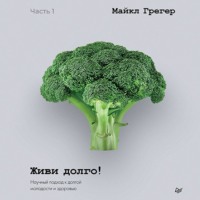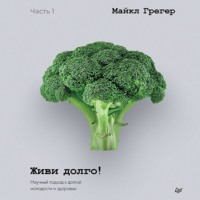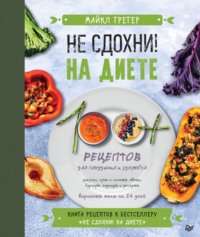
Полная версия
Живи долго! Научный подход к долгой молодости и здоровью
2972
Król W, Price S, Sliz D, et al. A vegan athlete’s heart – is it different? Morphology and function in echocardiography. Diagnostics (Basel). 2020;10(7):E477. https://pubmed.ncbi.nlm.nih.gov/32674452/
2973
Veleba J, Matoulek M, Hill M, Pelikanova T, Kahleova H. “A vegetarian vs. conventional hypocaloric diet: the effect on physical fitness in response to aerobic exercise in patients with type 2 diabetes.” A parallel randomized study. Nutrients. 2016;8(11):671. https://pubmed.ncbi.nlm.nih.gov/27792174/
2974
Veleba J, Matoulek M, Hill M, Pelikanova T, Kahleova H. “A vegetarian vs. conventional hypocaloric diet: the effect on physical fitness in response to aerobic exercise in patients with type 2 diabetes.” A parallel randomized study. Nutrients. 2016;8(11):671. https://pubmed.ncbi.nlm.nih.gov/27792174/
2975
Kahleova H, Hrachovinova T, Hill M, Pelikanova T. Vegetarian diet in type 2 diabetes – improvement in quality of life, mood and eating behaviour. Diabet Med. 2013;30(1):127–9. https://pubmed.ncbi.nlm.nih.gov/23050853/
2976
Kien CL, Bunn JY, Tompkins CL, et al. Substituting dietary monounsaturated fat for saturated fat is associated with increased daily physical activity and resting energy expenditure and with changes in mood. Am J Clin Nutr. 2013;97(4):689–97. https://pubmed.ncbi.nlm.nih.gov/23446891/
2977
Dumas JA, Bunn JY, Nickerson J, et al. Dietary saturated fat and monounsaturated fat have reversible effects on brain function and the secretion of pro-inflammatory cytokines in young women. Metab Clin Exp. 2016;65(10):1582–8. https://pubmed.ncbi.nlm.nih.gov/27621193/
2978
Kien CL, Bunn JY, Tompkins CL, et al. Substituting dietary monounsaturated fat for saturated fat is associated with increased daily physical activity and resting energy expenditure and with changes in mood. Am J Clin Nutr. 2013;97(4):689–97. https://pubmed.ncbi.nlm.nih.gov/23446891/
2979
Kahleova H, Matoulek M, Malinska H, et al. Vegetarian diet improves insulin resistance and oxidative stress markers more than conventional diet in subjects with Type 2 diabetes. Diabet Med. 2011;28(5):549–59. https://pubmed.ncbi.nlm.nih.gov/21480966/
2980
Roderka MN, Puri S, Batsis JA. Addressing obesity to promote healthy aging. Clin Geriatr Med. 2020;36(4):631–43. https://pubmed.ncbi.nlm.nih.gov/33010899/
2981
Hales CM, Carroll MD, Fryar CD, Ogden CL. Prevalence of obesity and severe obesity among adults: United States, 2017–2018. NCHS Data Brief. 2020;(360):1–8. https://pubmed.ncbi.nlm.nih.gov/32487284/
2982
Pontzer H, Yamada Y, Sagayama H, et al. Daily energy expenditure through the human life course. Science. 2021;373(6556):808–12. https://pubmed.ncbi.nlm.nih.gov/34385400/
2983
Tam BT, Morais JA, Santosa S. Obesity and ageing: two sides of the same coin. Obes Rev. 2020;21(4):e12991. https://pubmed.ncbi.nlm.nih.gov/32020741/
2984
Himbert C, Thompson H, Ulrich CM. Effects of intentional weight loss on markers of oxidative stress, DNA repair and telomere length – a systematic review. Obes Facts. 2017;10(6):648–65. https://pubmed.ncbi.nlm.nih.gov/29237161/
2985
Bianchi VE. Weight loss is a critical factor to reduce inflammation. Clin Nutr ESPEN. 2018;28:21–35. https://pubmed.ncbi.nlm.nih.gov/30390883/
2986
Tam BT, Morais JA, Santosa S. Obesity and ageing: two sides of the same coin. Obes Rev. 2020;21(4):e12991. https://pubmed.ncbi.nlm.nih.gov/32020741/
2987
Ronan L, Alexander-Bloch AF, Wagstyl K, et al. Obesity associated with increased brain age from midlife. Neurobiol Aging. 2016;47:63–70. https://pubmed.ncbi.nlm.nih.gov/27562529/
2988
Albanese E, Launer LJ, Egger M, et al. Body mass index in midlife and dementia: systematic review and meta-regression analysis of 589,649 men and women followed in longitudinal studies. Alzheimers Dement (Amst). 2017;8:165–78. https://pubmed.ncbi.nlm.nih.gov/28761927/
2989
Chuang YF, An Y, Bilgel M, et al. Midlife adiposity predicts earlier onset of Alzheimer’s dementia, neuropathology and presymptomatic cerebral amyloid accumulation. Mol Psychiatry. 2016;21(7):910–5. https://pubmed.ncbi.nlm.nih.gov/26324099/
2990
Olshansky SJ, Passaro DJ, Hershow RC, et al. A potential decline in life expectancy in the United States in the 21st century. N Engl J Med. 2005;352(11):1138–45. https://pubmed.ncbi.nlm.nih.gov/15784668/
2991
Ludwig DS. Lifespan weighed down by diet. JAMA. 2016;315(21):2269–70. https://pubmed.ncbi.nlm.nih.gov/27043490/
2992
Mann CC. Provocative study says obesity may reduce U.S. life expectancy. Science. 2005;307(5716):1716–7. https://pubmed.ncbi.nlm.nih.gov/15774742/
2993
Sun Q, Townsend MK, Okereke OI, Franco OH, Hu FB, Grodstein F. Adiposity and weight change in mid-life in relation to healthy survival after age 70 in women: prospective cohort study. BMJ. 2009;339:b3796. https://pubmed.ncbi.nlm.nih.gov/20101015/
2994
Santos-Lozano A, Pareja-Galeano H, Fuku N, et al. Implications of obesity in exceptional longevity. Ann Transl Med. 2016;4(20):416. https://pubmed.ncbi.nlm.nih.gov/27867968/
2995
Tam BT, Morais JA, Santosa S. Obesity and ageing: two sides of the same coin. Obes Rev. 2020;21(4):e12991. https://pubmed.ncbi.nlm.nih.gov/32020741/
2996
Pararasa C, Bailey CJ, Griffiths HR. Ageing, adipose tissue, fatty acids and inflammation. Biogerontology. 2015;16(2):235–48. https://pubmed.ncbi.nlm.nih.gov/25367746/
2997
Rubin R. Postmenopausal women with a “normal” BMI might be overweight or even obese. JAMA. 2018;319(12):1185–7. https://pubmed.ncbi.nlm.nih.gov/29516084/
2998
Jayedi A, Soltani S, Zargar MS, Khan TA, Shab-Bidar S. Central fatness and risk of all cause mortality: systematic review and dose-response meta-analysis of 72 prospective cohort studies. BMJ. 2020;370:m3324. https://pubmed.ncbi.nlm.nih.gov/32967840/
2999
Klein S, Fontana L, Young VL, et al. Absence of an effect of liposuction on insulin action and risk factors for coronary heart disease. N Engl J Med. 2004;350(25):2549–57. https://pubmed.ncbi.nlm.nih.gov/15201411/
3000
Blackburn G. Effect of degree of weight loss on health benefits. Obes Res. 1995;3 Suppl 2:211s-6s. https://pubmed.ncbi.nlm.nih.gov/8581779/
3001
Klein S, Fontana L, Young VL, et al. Absence of an effect of liposuction on insulin action and risk factors for coronary heart disease. N Engl J Med. 2004;350(25):2549–57. https://pubmed.ncbi.nlm.nih.gov/15201411/
3002
Chaston TB, Dixon JB. Factors associated with percent change in visceral versus subcutaneous abdominal fat during weight loss: findings from a systematic review. Int J Obes (Lond). 2008;32(4):619–28. https://pubmed.ncbi.nlm.nih.gov/18180786/
3003
Haywood C, Sumithran P. Treatment of obesity in older persons – a systematic review. Obes Rev. 2019;20(4):588–98. https://pubmed.ncbi.nlm.nih.gov/30645010/
3004
Muzumdar R, Allison DB, Huffman DM, et al. Visceral adipose tissue modulates mammalian longevity. Aging Cell. 2008;7(3):438–40. https://pubmed.ncbi.nlm.nih.gov/18363902/
3005
Wiggins T, Guidozzi N, Welbourn R, Ahmed AR, Markar SR. Association of bariatric surgery with all-cause mortality and incidence of obesity-related disease at a population level: a systematic review and meta-analysis. PLoS Med. 2020;17(7):e1003206. https://pubmed.ncbi.nlm.nih.gov/32722673/
3006
Kritchevsky SB, Beavers KM, Miller ME, et al. Intentional weight loss and all-cause mortality: a meta-analysis of randomized clinical trials. PLoS One. 2015;10(3):e0121993. https://pubmed.ncbi.nlm.nih.gov/25794148/
3007
Wright N, Wilson L, Smith M, Duncan B, McHugh P. The BROAD study: a randomised controlled trial using a whole food plant-based diet in the community for obesity, ischaemic heart disease or diabetes. Nutr Diabetes. 2017;7(3):e256. https://pubmed.ncbi.nlm.nih.gov/28319109/
3008
Hall KD, Guo J, Courville AB, et al. Effect of a plant-based, low-fat diet versus an animal-based, ketogenic diet on ad libitum energy intake. Nat Med. 2021;27(2):344–53. https://pubmed.ncbi.nlm.nih.gov/33479499/
3009
Piers LS, Walker KZ, Stoney RM, Soares MJ, O’Dea K. Substitution of saturated with monounsaturated fat in a 4-week diet affects body weight and composition of overweight and obese men. Br J Nutr. 2003;90(3):717–27. https://pubmed.ncbi.nlm.nih.gov/13129479/
3010
Rosqvist F, Iggman D, Kullberg J, et al. Overfeeding polyunsaturated and saturated fat causes distinct effects on liver and visceral fat accumulation in humans. Diabetes. 2014;63(7):2356–68. https://pubmed.ncbi.nlm.nih.gov/24550191/
3011
Krishnan S, Cooper JA. Effect of dietary fatty acid composition on substrate utilization and body weight maintenance in humans. Eur J Nutr. 2014;53(3):691–710. https://pubmed.ncbi.nlm.nih.gov/24363161/
3012
Jonnalagadda SS, Egan SK, Heimbach JT, et al. Fatty acid consumption pattern of Americans: 1987–1988 USDA Nationwide Food Consumption Survey. Nutr Res. 1995;15(12):1767–81. https://agris.fao.org/agris-search/search.do?recordID=US19970167025
3013
Pimenta AS, Gaidhu MP, Habib S, et al. Prolonged exposure to palmitate impairs fatty acid oxidation despite activation of AMP-activated protein kinase in skeletal muscle cells. J Cell Physiol. 2008;217(2):478–85. https://pubmed.ncbi.nlm.nih.gov/18561258/
3014
Chen YC, Cypess AM, Chen YC, et al. Measurement of human brown adipose tissue volume and activity using anatomic MR imaging and functional MR imaging. J Nucl Med. 2013;54(9):1584–7. https://pubmed.ncbi.nlm.nih.gov/23868958/
3015
Darcy J, Tseng YH. ComBATing aging – does increased brown adipose tissue activity confer longevity? GeroScience. 2019;41(3):285–96. https://pubmed.ncbi.nlm.nih.gov/31230192/
3016
Darcy J, Tseng YH. ComBATing aging – does increased brown adipose tissue activity confer longevity? GeroScience. 2019;41(3):285–96. https://pubmed.ncbi.nlm.nih.gov/31230192/
3017
Ortega-Molina A, Efeyan A, Lopez-Guadamillas E, et al. Pten positively regulates brown adipose function, energy expenditure, and longevity. Cell Metab. 2012;15(3):382–94. https://pubmed.ncbi.nlm.nih.gov/22405073/
3018
Vatner DE, Zhang J, Oydanich M, et al. Enhanced longevity and metabolism by brown adipose tissue with disruption of the regulator of G protein signaling 14. Aging Cell. 2018;17(4):e12751. https://pubmed.ncbi.nlm.nih.gov/29654651/
3019
Hoffman JM, Valencak TG. Sex differences and aging: is there a role of brown adipose tissue? Mol Cell Endocrinol. 2021;531:111310. https://pubmed.ncbi.nlm.nih.gov/33989715/
3020
Dong M, Lin J, Lim W, Jin W, Lee HJ. Role of brown adipose tissue in metabolic syndrome, aging, and cancer cachexia. Front Med. 2018;12(2):130–8. https://pubmed.ncbi.nlm.nih.gov/29119382/
3021
Rogers NH. Brown adipose tissue during puberty and with aging. Ann Med. 2015;47(2):142–9. https://pubmed.ncbi.nlm.nih.gov/24888388/
3022
Fuse S, Endo T, Tanaka R, et al. Effects of capsinoid intake on brown adipose tissue vascular density and resting energy expenditure in healthy, middle-aged adults: a randomized, double-blind, placebo-controlled study. Nutrients. 2020;12(9):E2676. https://pubmed.ncbi.nlm.nih.gov/32887379/
3023
Smeets AJ, Janssens PL, Westerterp-Plantenga MS. Addition of capsaicin and exchange of carbohydrate with protein counteract energy intake restriction effects on fullness and energy expenditure. J Nutr. 2013;143(4):442–7. https://pubmed.ncbi.nlm.nih.gov/23406619/
3024
Sugita J, Yoneshiro T, Hatano T, et al. Grains of paradise (Aframomum melegueta) extract activates brown adipose tissue and increases whole-body energy expenditure in men. Br J Nutr. 2013;110(4):733–8. https://pubmed.ncbi.nlm.nih.gov/23308394/
3025
Maharlouei N, Tabrizi R, Lankarani KB, et al. The effects of ginger intake on weight loss and metabolic profiles among overweight and obese subjects: a systematic review and meta-analysis of randomized controlled trials. Crit Rev Food Sci Nutr. 2018:1–14.; https://pubmed.ncbi.nlm.nih.gov/29393665/
3026
Pellagra: secondary to antiobesity diet. Postgrad Med. 1955;17(3):37. https://pubmed.ncbi.nlm.nih.gov/14371224/
3027
Afshin A, Forouzanfar MH, Reitsma BS, et al. Correspondence: health effects of overweight and obesity in 195 countries over 25 years. N Engl J Med. 2017;377(1):13–27. https://pubmed.ncbi.nlm.nih.gov/28604169/
3028
Berrigan D, Troiano RP, Graubard BI. BMI and mortality: the limits of epidemiological evidence. Lancet. 2016;388(10046):734–6. https://pubmed.ncbi.nlm.nih.gov/27423263/
3029
Berrington de Gonzalez A, Hartge P, Cerhan JR, et al. Body-mass index and mortality among 1.46 million white adults. N Engl J Med. 2010;363(23):2211–9. https://pubmed.ncbi.nlm.nih.gov/21121834/
3030
Afshin A, Forouzanfar MH, Reitsma BS, et al. Correspondence: health effects of overweight and obesity in 195 countries over 25 years. N Engl J Med. 2017;377(1):13–27. https://pubmed.ncbi.nlm.nih.gov/28604169/
3031
Aune D, Sen A, Prasad M, et al. BMI and all cause mortality: systematic review and non-linear dose-response meta-analysis of 230 cohort studies with 3.74 million deaths among 30.3 million participants. BMJ. 2016;353:i2156. https://pubmed.ncbi.nlm.nih.gov/27146380/
3032
Greger M, Stone G. How Not to Die. Flatiron Books; 2015. https://www.worldcat.org/title/946602582
3033
Rae DE, Ebrahim I, Roden LC. Sleep: a serious contender for the prevention of obesity and non-communicable diseases. JEMDSA. 2016;21(1):1–2. https://www.tandfonline.com/doi/full/10.1080/16089677.2016.1150574
3034
Liu H, Chen A. Roles of sleep deprivation in cardiovascular dysfunctions. Life Sci. 2019;219:231–7. https://pubmed.ncbi.nlm.nih.gov/30630005/
3035
Möller-Levet CS, Archer SN, Bucca G, et al. Effects of insufficient sleep on circadian rhythmicity and expression amplitude of the human blood transcriptome. Proc Natl Acad Sci U S A. 2013;110(12):E1132–41. https://pubmed.ncbi.nlm.nih.gov/23440187/
3036
Calvin AD, Covassin N, Kremers WK, et al. Experimental sleep restriction causes endothelial dysfunction in healthy humans. J Am Heart Assoc. 2014;3(6):e001143. https://pubmed.ncbi.nlm.nih.gov/25424573/
3037
Kohansieh M, Makaryus AN. Sleep deficiency and deprivation leading to cardiovascular disease. Int J Hypertens. 2015;2015:615681. https://pubmed.ncbi.nlm.nih.gov/26495139/
3038
Calvin AD, Covassin N, Kremers WK, et al. Experimental sleep restriction causes endothelial dysfunction in healthy humans. J Am Heart Assoc. 2014;3(6):e001143. https://pubmed.ncbi.nlm.nih.gov/25424573/
3039
Krueger PM, Friedman EM. Sleep duration in the United States: a cross-sectional population-based study. Am J Epidemiol. 2009;169(9):1052–63. https://pubmed.ncbi.nlm.nih.gov/19299406/
3040
Golem DL, Martin-Biggers JT, Koenings MM, Davis KF, Byrd-Bredbenner C. An integrative review of sleep for nutrition professionals. Adv Nutr. 2014;5(6):742–59. https://pubmed.ncbi.nlm.nih.gov/25398735/
3041
Shen J, Yang P, Luo X, et al. Green light extends Drosophila longevity. Exp Gerontol. 2021;147:111268. https://pubmed.ncbi.nlm.nih.gov/33539986/
3042
Shen J, Yang P, Luo X, et al. Green light extends Drosophila longevity. Exp Gerontol. 2021;147:111268. https://pubmed.ncbi.nlm.nih.gov/33539986/
3043
Bosman ES, Albert AY, Lui H, Dutz JP, Vallance BA. Skin exposure to narrow band ultraviolet (UVB) light modulates the human intestinal microbiome. Front Microbiol. 2019;10:2410. https://pubmed.ncbi.nlm.nih.gov/31708890/
3044
Shen J, Yang P, Luo X, et al. Green light extends Drosophila longevity. Exp Gerontol. 2021;147:111268. https://pubmed.ncbi.nlm.nih.gov/33539986/
3045
Li Q, Kobayashi M, Wakayama Y, et al. Effect of phytoncide from trees on human natural killer cell function. Int J Immunopathol Pharmacol. 2009;22(4):951–9. https://pubmed.ncbi.nlm.nih.gov/20074458/
3046
Opperhuizen AL, Stenvers DJ, Jansen RD, Foppen E, Fliers E, Kalsbeek A. Light at night acutely impairs glucose tolerance in a time-, intensity- and wavelength-dependent manner in rats. Diabetologia. 2017;60(7):1333–43. https://pubmed.ncbi.nlm.nih.gov/28374068/
3047
Kurina LM, McClintock MK, Chen JH, Waite LJ, Thisted RA, Lauderdale DS. Sleep duration and all-cause mortality: a critical review of measurement and associations. Ann Epidemiol. 2013;23(6):361–70. https://pubmed.ncbi.nlm.nih.gov/23622956/
3048
He M, Deng X, Zhu Y, Huan L, Niu W. The relationship between sleep duration and all-cause mortality in the older people: an updated and dose-response meta-analysis. BMC Public Health. 2020;20(1):1179. https://pubmed.ncbi.nlm.nih.gov/32723316/
3049
Yetish G, Kaplan H, Gurven M, et al. Natural sleep and its seasonal variations in three pre-industrial societies. Curr Biol. 2015;25(21):2862–8. https://pubmed.ncbi.nlm.nih.gov/26480842/
3050
Shen X, Wu Y, Zhang D. Nighttime sleep duration, 24-hour sleep duration and risk of all-cause mortality among adults: a meta-analysis of prospective cohort studies. Sci Rep. 2016;6:21480. https://pubmed.ncbi.nlm.nih.gov/26900147/
3051
García-Perdomo HA, Zapata-Copete J, Rojas-Cerón CA. Sleep duration and risk of all-cause mortality: a systematic review and meta-analysis. Epidemiol Psychiatr Sci. 2018;Jul 30:1–11. https://pubmed.ncbi.nlm.nih.gov/30058510/
3052
Knutson KL, Turek FW. The U-shaped association between sleep and health: the 2 peaks do not mean the same thing. Sleep. 2006;29(7):878–9. https://pubmed.ncbi.nlm.nih.gov/16895253/
3053
Grandner MA, Drummond SPA. Who are the long sleepers? Towards an understanding of the mortality relationship. Sleep Med Rev. 2007;11(5):341–60. https://pubmed.ncbi.nlm.nih.gov/17625932/
3054
Kurina LM, McClintock MK, Chen JH, Waite LJ, Thisted RA, Lauderdale DS. Sleep duration and all-cause mortality: a critical review of measurement and associations. Ann Epidemiol. 2013;23(6):361–70. https://pubmed.ncbi.nlm.nih.gov/23622956/
3055
Hirshkowitz M, Whiton K, Albert SM, et al. National Sleep Foundation’s sleep time duration recommendations: methodology and results summary. Sleep Health. 2015;1(1):40–3. https://pubmed.ncbi.nlm.nih.gov/29073412/
3056
Pourmotabbed A, Boozari B, Babaei A, et al. Sleep and frailty risk: a systematic review and meta-analysis. Sleep Breath. 2020;24(3):1187–97. https://pubmed.ncbi.nlm.nih.gov/32215833/
3057
Pourmotabbed A, Ghaedi E, Babaei A, et al. Sleep duration and sarcopenia risk: a systematic review and dose-response meta-analysis. Sleep Breath. 2020;24(4):1267–78. https://pubmed.ncbi.nlm.nih.gov/31832982/
3058
Schwarz EI, Puhan MA, Schlatzer C, Stradling JR, Kohler M. Effect of CPAP therapy on endothelial function in obstructive sleep apnoea: a systematic review and meta-analysis. Respirology. 2015;20(6):889–95. https://pubmed.ncbi.nlm.nih.gov/26073295/
3059
Bjorvatn B, Fiske E, Pallesen S. A self-help book is better than sleep hygiene advice for insomnia: a randomized controlled comparative study. Scand J Psychol. 2011;52(6):580–5. https://pubmed.ncbi.nlm.nih.gov/21790620/
3060
Ancoli-Israel S. Sleep problems in older adults: putting myths to bed. Geriatrics. 1997;52(1):20–30. https://pubmed.ncbi.nlm.nih.gov/9003201/
3061
Miner B, Kryger MH. Sleep in the aging population. Sleep Med Clin. 2017;12(1):31–8. https://pubmed.ncbi.nlm.nih.gov/28159095/
3062
Lovato N, Lack L. Insomnia and mortality: a meta-analysis. Sleep Med Rev. 2019;43:71–83. https://pubmed.ncbi.nlm.nih.gov/30529432/
3063
Barclay NL, Kocevska D, Bramer WM, Van Someren EJW, Gehrman P. The heritability of insomnia: a meta-analysis of twin studies. Genes Brain Behav. 2021;20(4):e12717. https://pubmed.ncbi.nlm.nih.gov/33222383/
3064
Machado FV, Louzada LL, Cross NE, Camargos EF, Dang-Vu TT, Nóbrega OT. More than a quarter century of the most prescribed sleeping pill: systematic review of zolpidem use by older adults. Exp Gerontol. 2020;136:110962. https://pubmed.ncbi.nlm.nih.gov/32360985/
3065
Kripke DF, Langer RD, Kline LE. Hypnotics’ association with mortality or cancer: a matched cohort study. BMJ Open. 2012;2(1):1–10. https://pubmed.ncbi.nlm.nih.gov/22371848/
3066
Baber R. Climacteric commentaries. Better sleep but higher mortality risk. Climacteric. 2012;15(4):401. https://pubmed.ncbi.nlm.nih.gov/22950121/
3067
Kripke DF, Langer RD, Kline LE. Hypnotics’ association with mortality or cancer: a matched cohort study. BMJ Open. 2012;2(1):1–10. https://pubmed.ncbi.nlm.nih.gov/22371848/
3068
Rabin RC. New worries about sleeping pills. The New York Times: Well. https://well.blogs.nytimes.com/2012/03/12/new-worries-about-sleeping-pills. Published March 12, 2012. Accessed April 17, 2019.; https://well.blogs.nytimes.com/2012/03/12/new-worries-about-sleeping-pills
3069
Kripke DF. Mortality risk of hypnotics: strengths and limits of evidence. Drug Saf. 2016;39(2):93–107. https://pubmed.ncbi.nlm.nih.gov/26563222/
3070
Bianchi MT, Thomas RJ, Ellenbogen JM. Hypnotics and mortality risk. J Clin Sleep Med. 2012;8(4):351–2. https://pubmed.ncbi.nlm.nih.gov/22893762/
3071
Kripke DF, Langer RD, Kline LE. Do no harm: not even to some degree. J Clin Sleep Med. 2012;8(4):353–4. https://pubmed.ncbi.nlm.nih.gov/22893763/
3072
Huedo-Medina TB, Kirsch I, Middlemass J, Klonizakis M, Siriwardena AN. Effectiveness of non-benzodiazepine hypnotics in treatment of adult insomnia: meta-analysis of data submitted to the Food and Drug Administration. BMJ. 2012;345. https://pubmed.ncbi.nlm.nih.gov/23248080/













